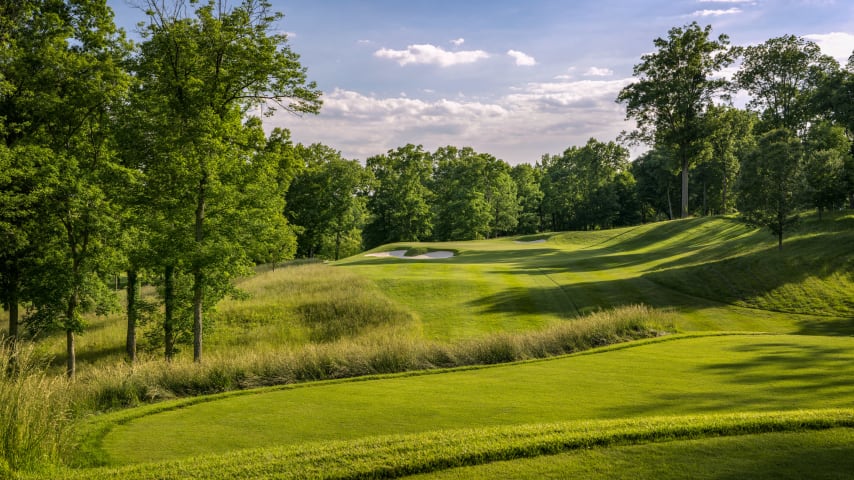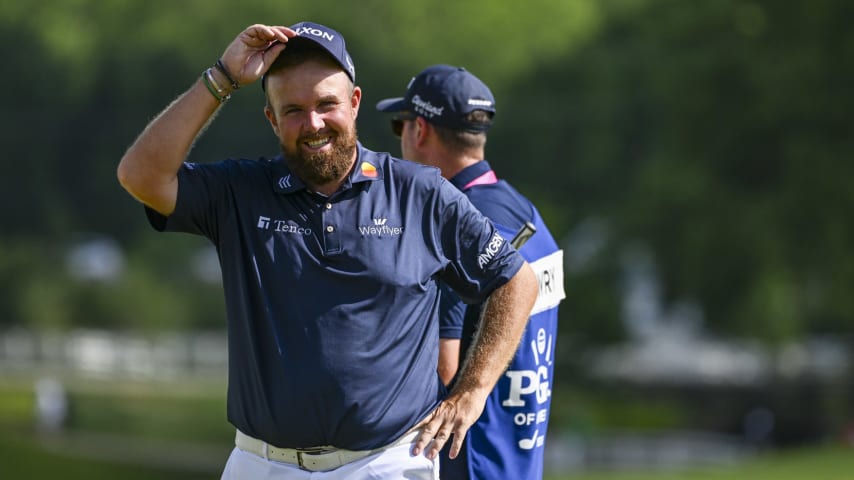The Five: Looking back at Tiger Woods' best 72nd-hole putts

Tiger Woods’ most clutch shots on the final hole of tournaments
Written by Sean Martin
Tiger Woods’ dominance inspired awe, but it was the close calls that were the most memorable.
A runaway win is the product of sustained excellence over the course of a week. It is often devoid of drama and lacks that single memorable moment. The final round becomes a formality.
Woods set records with his double-digit victories. But it is the ones that came down to a single stroke, when Woods had to summon everything he had to win by the slimmest of margins, that are burnished in our memories.
The 2000 PGA Championship at Valhalla Golf Club was one such example, when Woods, in the midst of the greatest run golf had ever seen, needed a playoff to beat winless Bob May. Woods running after his birdie putt on the opening playoff hole and pointing at the hole is the trademark image from that tournament, but it was the birdie putt that preceded it that Woods calls the best putt of his career. A slick, sliding 7-foot birdie putt on the 18th green was necessary just to force extra holes.
The PGA Championship – and Woods – return to Valhalla this week. To mark the occasion, this week’s edition of The Five will look at the best 72nd-hole birdie putts of Woods’ career.
1. 2000 PGA Championship (7 feet for birdie): When considering Woods’ best 72nd-hole birdie putts, many minds may wander immediately to the 2008 U.S. Open at Torrey Pines. The one that Woods made on Valhalla’s 18th green may not even be his most famous putt from the 2000 PGA.
But Woods himself still considers his birdie putt to force a playoff with Bob May the most important of his career. This slick, sliding 7-footer kept history alive.
“Considering the circumstance, the pressure, the putt that was so, so, so fast, and the break, that was the one,” Woods told Golfweek when asked for the most important putt of his career. “Dead center.”
Woods had won the previous two majors by a combined 23 shots, but he needed every single stroke to beat May at Valhalla in 2000. Woods’ 7-foot birdie putt at the last forced a playoff with the winless veteran, who just moments earlier had holed a 15-footer for a birdie of his own.
Those birdie putts completed back-nine 31s for both Woods and May. Woods said: “It’s got to go down as one of the best duels in the game in major championships.”

Tiger Woods recaps his four PGA Championship wins
Woods went on to hole a 20-foot birdie putt on the first extra hole, running after the ball and pointing at the hole as his ball fell. It was the indelible image of that tournament.
By winning at Valhalla, Woods became the first man since Ben Hogan to win three majors in a single year, and was the third leg of the "Tiger Slam," which he completed at Augusta National the following April.
“I was going for three majors in a row there,” Woods told Golfweek about his birdie putt to force the playoff. “It was the circumstance, the pressure, how well Bob and I played. It was a hell of a shootout and it came in a major. We were matching each other with birdies in a major. That putt on 18, everything on the line, gave me a chance to win. Yeah, that was the one.”
2. 2008 U.S. Open (8 feet for birdie): Eight years after Valhalla, Woods needed to birdie another par 5 to force a playoff with another pesky underdog who would not give an inch. This time, Woods had to hole an 8-foot birdie putt on Torrey Pines’ 18th to force a playoff with Rocco Mediate.
The ball stayed true to its line despite hitting several spike marks en route to the hole. Woods compared the ball’s bumpy route to the Plinko game from “The Price is Right.” NBC’s Dan Hicks rhetorically exclaimed, “Expect anything different?” when the ball curled in.

A new plaque honoring Tiger Woods' putt on the 18th green at the 2008 U.S. Open at Torrey Pines Golf Course. (Ezra Shaw/Getty Images)
“That was actually one of the worst parts of the green. It's so bumpy down there,” Woods said. “And I just kept telling myself two and a half balls outside the right, but make sure you stay committed to it, make a pure stroke and if it plinkos in, or plinkos out it doesn't matter, as long as I make a pure stroke. And I did. I hit it good. It took forever to break, but it finally snuck in there at the end.”
Woods and Mediate went to an 18-hole playoff the following day. They were tied at the end of the extra round, as well. Woods finally won on the 19th hole of the day. He’d not only won what amounted to a hometown major but did so with two stress fractures in his left leg and a torn ACL. It was all made possible by that birdie putt at 18.
3. 2009 Arnold Palmer Invitational (16 feet for birdie): This isn’t even the longest birdie putt that Woods made to win on Bay Hill’s 18th green. He gets extra credit for holing it in the dark, however. Flashbulbs illuminated Woods’ spirited celebration after he holed a 16-foot birdie putt to complete a comeback from a five-shot deficit. It also gave Woods a win in just his second stroke-play event after the knee surgery that followed the previous year’s U.S. Open.
Bay Hill’s 18th is one of the hardest finishing holes on the PGA TOUR thanks to a green guarded by water and rocks, but three of Woods’ eight victories in the Arnold Palmer Invitational presented by Mastercard came after he birdied it to win by one.
The first of Woods’ winning birdie putts at Bay Hill came in 2001, when he holed a 15-foot birdie putt to beat Phil Mickelson by one. Seven years later, Woods holed a 25-footer for birdie to finish one shot ahead of Bart Bryant. Woods repeated his 18th-hole heroics the next year, making his 16-footer in the dark after storms delayed the final round. Woods started the final round five behind Sean O’Hair but won by a single shot after yet another birdie at 18.
“This putt was uphill," Woods said. "The other two were downhill left to right. This one was uphill; not only that, it was into the grain left to right. The other two putts were kind of similar, but this was totally different.
"I kept telling myself … if you make any mistake, over-release the blade and miss it left so at least it has a chance … I hit a pure putt. I hit it really solid and it held its line all the way there.”
You could fill almost this entire list with his birdies at Bay Hill, but we’d like to spread the wealth.
4. 2001 Masters (18 feet for birdie): Woods needed only a two-putt at Augusta National’s 18th green to win a fourth consecutive major. Instead, he finished one of golf’s greatest accomplishments in fitting manner. He sank his 18-foot birdie putt, ending the Tiger Slam with an exclamation point.
Woods won the four majors in a variety of ways. His streak started with his 15-shot win in the 2000 U.S. Open. He won The Open at St. Andrews by eight. Then he needed a playoff to beat May at Valhalla. And at the 2001 Masters, Woods held off his two biggest rivals at the time, Phil Mickelson and David Duval, in the final round. When it was all over, Woods gathered himself at the side of the green and hid his face in his cap.
“When I didn't have anymore shots to play, that's when I started to realize what I had done; I won the tournament, and I started getting a little emotional, and trying to pull it together,” he said. “I've done it before I've cried after wins. I've cried after defeats. But I've never had that feeling before, because I was , I guess, so attuned to each and every shot, that I focused so hard on just that one golf shot and that's it, that I finally realized, I had no more to play.”
5. 2000 The Sentry (12-foot eagle putt): Woods’ 2000 season may be the greatest in golf history. He won a career-high nine times, including three major championships. It started with one of the most dramatic wins of Woods’ career, over the player who suffered the most from Woods’ dominance.
Woods and Ernie Els were tied when they arrived at the 72nd hole at Kapalua’s Plantation Course. Both players reached the green on the long, downhill hole in two. Woods made his 12-foot eagle putt first, and Els matched to send things to sudden death. Like those strokes at Valhalla and Torrey Pines, Woods’ putt at the end of regulation set the stage for playoff heroics. Both began the playoff by two-putting the 18th for birdie. Woods won on the next hole by holing a 40-footer for birdie.
"I think he's a legend in the making," said Els, who was runner-up to Woods four times that season, including in Woods’ 15-shot U.S. Open win and eight-shot victory at The Open. "You guys have helped, but he's backed it up with his golf game. He's 24. He's probably going to be bigger than Elvis when he gets into his 40s."







